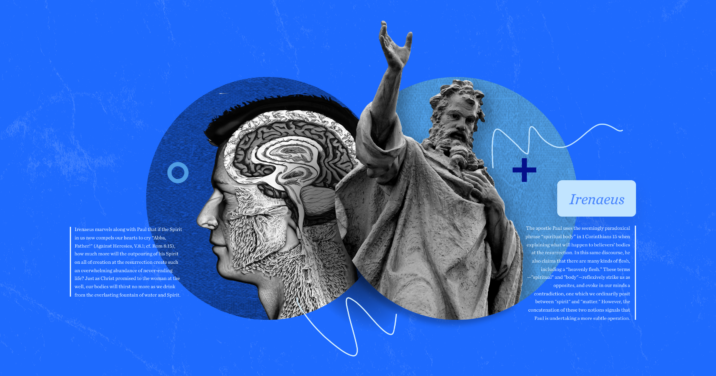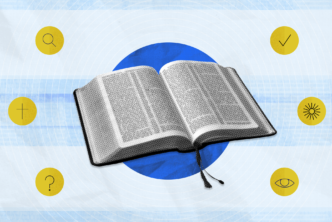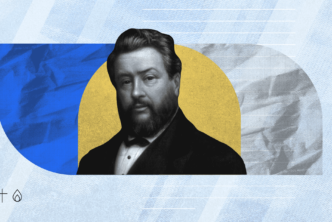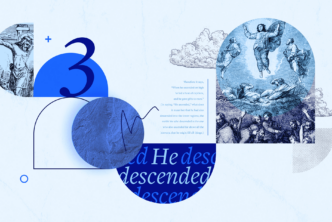The apostle Paul uses the seemingly paradoxical phrase “spiritual body” in 1 Corinthians 15 when explaining what will happen to believers’ bodies at the resurrection. In this same discourse, he also claims that there are many kinds of flesh, including a “heavenly flesh.” These terms—“spiritual” and “body”—reflexively strike us as opposites. They evoke in our minds the contradiction we ordinarily posit between “spirit” and “matter.” However, the concatenation of these two notions signals that Paul is undertaking a more subtle operation.
Through a shift of perspective, we can see that spirit and body do not oppose one another on equal terms, but rather are circumscribed within each other, operating on different planes while nonetheless remaining interrelated. We find such a framework in Paul for linking spirit and body together. This essay reads Paul’s theology of resurrection in 1 Corinthians 15 alongside the struggles of the early church in her battle against Gnosticism, and then draws from the writings of Irenaeus of Lyon (AD 130–202) to help articulate a biblical understanding of the spiritual body.
Under this non-competitive schema of spirit and matter, we understand the heavenly flesh of a spiritual body as flesh which is fully alive with the Spirit of God, the Lord and giver of Life. The spiritual body which Paul describes here evokes not disembodied forms or apparitions, but bodies saturated in the Spirit.1 Such bodies find themselves so fully vivified and empowered that their former existence seems in comparison to have been like a shadow, almost like a dead man walking or one having been perpetually exhausted. The space opened up by the operation of the Spirit enables the creature to become fully itself, and these two are not in competition.
This conception of a spiritual body as “the body saturated with the Spirit” forces us to wrestle with Paul’s teaching that the body can be spiritual, but not in the way which the word “spiritual” has come to be used in most contemporary discourse, and certainly not by becoming any less of a body. His construction of the dialectical notion of the “spiritual body” cautions us against, on the one hand, the idea that the resurrection presents a religious fairy tale gesturing to a movement of the heart without touching the body, while on the other hand, warding off Gnostic-adjacent conceptions in which redemption consigns materiality to destruction, demanding a final escape from bodies.
Paul’s extended discourse in 1 Corinthians 15 on the believer’s transformation from a “natural body” (ψυχικὸς σῶμα) to a “spiritual body” (πνευματικός σῶμα) instructs us then in envisioning the intersection of three crucial theological threads—creation, redemption, and eschatology. The narrative movement of the natural body being sown like a seed and the spiritual body thereby growing into maturity from the natural body provides a vital schema for understanding the entire arc of God’s plan of redemption for his creation. The spiritual body which we receive through participation in Jesus Christ, the man of heaven, holds the key to these deep mysteries.
Body matters
In 1 Corinthians, Paul writes to a Corinthian church in turmoil: they are wracked by theological controversy, personal in-fighting, sexual sin, and much more. Paul spends the first four chapters recounting the story of his becoming an apostle, as well as how he brought the gospel to their community specifically, before he then proceeds in the next eleven chapters (chs. 5–15) to march through a laundry list of issues which he has heard reported concerning them. Paul addresses in his letter such issues as a man living in sexual sin with his stepmother (ch. 5), questions about eating meat sacrificed to idols (ch. 10), exclusion and indulgence at the Lord’s table (ch. 11), and many more besides. In one way or another, all the problems which Paul addresses in his letter to the Corinthian community trace back to the question of the body—its use, its value, its destiny.
“Do you not know that your bodies are members of Christ?” wonders an incredulous Paul (6:15), rebuking the Corinthian community while simultaneously pressing on the central issue from which their problems seem to flow. In his discussion of abstaining from sexual sins, specifically citing fornication and visiting prostitutes (6:12–20), Paul talks about how we can use our bodies to become united to things (v. 16 ), and in this way he raises the stakes about what we do with our bodies. Our bodies are us, which means that what we do becomes who we are. Later in the letter when he rebukes the Corinthians for practicing the Eucharist in an exclusionary and indulgent manner, he exhorts them to “discern the body,” which in context does not only mean that they need to properly apprehend Christ’s body in the elements, but even more importantly, that they must act consistently with the realization that their gathering together is what actually constitutes Christ’s body.
What is at stake for Paul and the Corinthians?
These questions about the body come to their climax in chapter 15 when Paul informs the Corinthians that he has heard that some of them have been denying the resurrection of the dead. Both in raising this theological controversy and in saving it for the end of the letter, Paul sets his sights squarely on what appears to me to be the root of the Corinthian church’s dysfunction: a fundamental confusion about the nature of the body and its role in God’s plan of salvation.
While we don’t know who in the Corinthian community was teaching a denial of the believer’s resurrection or why they were teaching it, in verses 31–34 Paul touches on the ethical implications of this belief, signaling that the denial of the resurrection of the body may be connected to certain lifestyle decisions. He adds at the end, “Do not be deceived; bad company corrupts good morals.” We might reasonably interpret Paul in this section to imply that whoever is propagating these ideas is trying to justify their own behavior, and likely seeking license to excuse sin.
Paul uses a phrase at the end of verse 32 to draw a hypothetical ethical conclusion about how one might be permitted to live if Christ had not in fact been raised from the dead: “Let us eat and drink, for tomorrow we die.” In these words, Paul paraphrases Isaiah 22.2 The prophet Isaiah puts these words in the mouths of the unrighteous Israelites who decided to party and feast when the prophets warned them about the impending enslavement of Jerusalem. Isaiah writes from the perspective of having witnessed the prophesied calamity befall Jerusalem, and he rebukes the Jewish people for ignoring God’s commands to repent while there was still time to avert the disaster. Paul’s words here send a similar warning to the Corinthian church, warning them not to act like drunken Israelites on the eve of Jerusalem’s destruction.
However, Paul’s phrasing evokes multiple interpretations, and thus some in the Corinthian community would also have heard in “let us eat and drink, for tomorrow we die” the ethical orientation of many Greek philosophies, especially Epicurean philosophy,3 which denied any life after death and proposed happiness as the ultimate goal of living.4 Living in a Greek port city and a prominent Roman colony, the Corinthians would have been awash in a diversity of philosophical perspectives, as well as inundated by the cultural pressures of the many pagan temples and their ritual excesses—most notable among these being the temple prostitution at the heart of the worship of Aphrodite.
Just like the elaborate system of pagan worship, philosophy in the Hellenistic world was not simply an assent to certain propositions in a logical system, but always included the adoption of a certain form of life and a regime of practices for self-formation.5 For example, Epicurus in his Letter to Menoeceus enjoins the reader with various commands about bodily discipline, such as maintaining a plain diet in order to increase one’s enjoyment of fine food, and also abstaining from overly sensual pleasures so that one does not disturb the soul. For teachers like Epicurus, philosophy is a working on one’s self. It’s precisely because Paul sees this that he wants his readers to conclude that the swapping of ideas doesn’t simply happen with our minds: our bodies, Paul is arguing, are transformed or “worked on” through their participation with things.
Eschatological narrative context
Regardless of who was spreading these ideas in the Corinthian community, Paul takes these claims very seriously, and views them as an unmitigated threat to the community at the level of both belief and practice. In the first half of chapter 15, his rhetorical strategy for countering this resurrection denial proceeds in three parts:
- Paul retells the story of the eyewitnesses who observed the living Christ in his body after his resurrection (vv. 3–11).
- Paul demonstrates for the Corinthians the necessary connection between Christ’s resurrection and their own (vv. 12–23).
- Paul reminds them of the centrality of the resurrection for God’s comprehensive plan for creation (vv. 24–28).
Paul begins by establishing the historical veracity of Jesus’ resurrection by recounting how the risen Christ appeared first to the apostles, then to five hundred people (many of whom are still alive, he notes), and finally even to himself (v. 8). Everything that Paul argues hangs on the historicity of this event, because from the reality of Christ’s dying and rising flows both the possibility of resurrection and the particular framework which Paul advances in this passage.
He then proceeds to speak of “firstfruits,” a concept which he borrows from the Feast of Weeks in the Torah (cf. Lev 23:15–22), in order to describe the necessary connection between Christ’s resurrection and a general resurrection (v. 20). In Israel, the firstfruits of the harvest were offered to God as a consecration of the whole harvest, and the people sacrificed these firstfruits in trust that God would provide the rest of the harvest as well in loving faithfulness to his people. In drawing on the image of the firstfruits, Paul also foreshadows the seed metaphor which he will deploy later in this chapter. As the firstfruits of the defeat of death, Christ’s resurrection is the seed which must flower into a full subjection of all creation unto God.
As he transitions to the conclusion of his argument, Paul elaborates an eschatological schema which tells the story of Christ’s return to reign and put every enemy into final subjection, including death, before he finally offers up the whole of creation to God the Father that “God may be all in all” (v. 28). This story of creation’s liberation from all her enemies, but especially from death, by way of Christ’s return and reign provides the narrative frame for Paul’s next discussion in which he analyzes the mechanics of resurrection.
The mechanics of resurrection: seeds, flesh, bodies
Paul anticipates an objection by proposing a question from a hypothetical interlocutor: “But how are the dead raised?” (v. 35). We can think here of the sort of sophistic quibbling that asks, “What if my decomposed body becomes part of the soil which nourishes a plant? What if a shark eats and digests my body? Who will get my molecules in the resurrection?” These questions typically are either the speculation of idle minds or are intended by skeptics to reduce the notion of resurrection to absurdity. As long as the church has proclaimed a future resurrection, she has had to grapple with these puzzles, both from within and from without.
At the outset of his response, Paul establishes a central motif by employing the metaphor of a seed which “dies” by being planted in the ground, whereby it may then sprout up into the mature form of the plant. “What you sow does not come to life unless it dies,” he states, but he continues by saying, “What is sown is not what will be, but only a kernel, like a grain of wheat” (vv. 36–37). Paul wants us to see two critical components of the logic of resurrection:
- Death is a necessary pre-condition to the full flowering of the body into its mature form in resurrection.
- What dies already contains this mature resurrected form.
While only God determines the type of flesh and appropriate glory into which the body–seed blooms at its resurrection, Paul clarifies that there are many varieties of flesh: human, animal, bird, and fish. Each type of flesh seems to represent a different type of seed which can grow up into a distinct form with its own corresponding glory. Here Paul first mentions an earthly body and a heavenly body, cluing us in to the existence of a heavenly flesh with a heavenly glory, but also setting up a couplet which he will play with later in the chapter by contrasting the natural body with spiritual body (v. 44) and the man of dust with the man of heaven (v. 47).
Paul then proceeds to advance a series of four mutually illuminating phrases, all following the same narrative movement of “being sown” and “rising” (vv. 42–44). With these four notions, Paul ties together all the concepts he has introduced to this point in the discourse: the weak and corruptible natural body is sown like a seed in the ground in order that in the resurrection it will bloom into a spiritual body, full of power and crowned with glory, never to see corruption again.
A life-giving Spirit
Having elaborated his extended conceit of the seed, Paul transplants this metaphor from abstract explanation into historical reality by articulating how the two historical figures, Adam and Christ, in their narrative relation reveal the underlying structure of all cosmic reality: the first Adam as the man of dust must come first, and then Jesus Christ, the man of heaven, comes next as the second Adam. As we have borne the image of the first Adam, Paul claims, we must also come to bear the image of the last Adam (v. 49), who possesses a spiritual body not subject to perishing.
Adam, the first man, received from God a natural body, but this body harbored the propensity for breaking down and becoming corrupted. Ultimately, this natural body was oriented towards being laid in the ground like a seed. Paul calls Adam a “living being,” and in so doing confirms that Adam was alive in a real sense, but also by referring to him as a “man of the dust,” Paul encourages us to see the life possessed by Adam’s natural body as preparatory and provisional.
The dust–body of the natural man, Adam, possesses a form of life, but this life is not from itself, and thus the man of dust is liable to wasting away. In Christ, God takes to himself a natural body, undergoing the travails of the dust–body’s corruptibility just as Adam and his descendants did, but in resurrection he reveals the mature form of this natural body, flowering into the full glory which he intends to gift to his creation: the abundant life of his Son Jesus Christ who became a life-giving Spirit through the Father’s raising him up from the dead.
In John’s Gospel, Jesus himself employs a seed analogy that is strikingly similar to Paul’s when he explains to his disciples what he will experience through his death and resurrection:
Very truly I tell you, unless a kernel of wheat falls to the ground and dies, it remains only a single seed. But if it dies, it produces many seeds. (John 12:24)
In this passage, Christ explicitly includes believers in this same narrative movement of the seed by prophesying that his dying and being sown will “produce many seeds” (or, in some translations, “bear much fruit”), thus multiplying and giving life to many others.
Whereas Adam, possessing the natural body, dies and is sown in the ground like a seed, the spiritual body of Christ becomes a “life-giving Spirit” (v. 45), which overflows with a life which it possesses from itself—an ascending form of life which enjoys its own incorruptibility, even offering this life as a gift to others from its super-plenitude. We know, however, from the Gospel narratives that this risen Christ who became a life-giving Spirit did not become less of a body. The apostle Thomas put his fingers in Christ’s wounds to confirm this for us. Thus, the life we receive through inheriting a spiritual body like Jesus the life-giving Spirit must represent for us a translation to a higher mode of bodily living which, while qualitatively different, does not constitute a fundamental departure from our natural body.
The spiritual person in Irenaeus of Lyon
The second-century bishop Irenaeus of Lyon (AD 130–202) also faced a growing denial of the resurrection of the body within the Christian communities he shepherded in Gaul. Since the church in the second century faced many of the same religious and ideological challenges which she did when Paul was writing, the writings of early church leaders like Irenaeus can shed light on how to read Scripture in the milieu in which it was written. To combat the Gnostic infiltration of churches in Gaul, Irenaeus penned a polemical work titled Against Heresies, in which he provides an extensive treatment of precisely the questions which Paul addresses in 1 Corinthians 15: What is the eschatological destiny of the body, and what does the salvation of the body teach us about the relation between the material and the spiritual?
In book 5 of Against Heresies, Irenaeus addresses head on the question of what it means to be a “spiritual person.” This question possessed vital importance in the battle against Gnostic groups, because the Gnostics postured themselves as spiritual people with unique access to deep metaphysical mysteries. Irenaeus needed to sharply distinguish the spirituality of the mystery cults from the Christian resurrection in which we receive spiritual bodies through participation in Jesus, the life-giving Spirit.
Nor does Irenaeus want to articulate simply what it means to “be spiritual” in a general sense, but rather what it means to be a spiritual person, for, as he points out, “Man is made after the image of God: man, not a part of man” (Against Heresies V.6.1). This properly Pauline spirituality maintains that the whole person is the object and locus of God’s saving action, and thus salvation of only a part of the human being would amount to a failure or lack of completion on God’s part.
Irenaeus says,
Such as the apostle also calls “spiritual” men: being as they are spiritual in regard of their partaking of the Spirit, but not in regard of any privation of the flesh, nor as being barely that thing [i.e., spiritual] alone. (Against Heresies V.6.1)
Irenaeus posits a model of the spiritual person as one who partakes of the Spirit, but without becoming any less of a material body (no “privation of the flesh” or “being barely that thing alone”). When Irenaeus points the Christians under his pastoral care towards the hope of the resurrection, he emphatically denies that the promised spiritual body entails a rejection of the natural body, but instead paints a picture for his readers of the flesh’s reception of abundant life through the indwelling of the Holy Spirit.
He describes the process very carefully,
When this Spirit who is mingled with the [human] soul is united to that which God formed, then by effusion of the Spirit the spiritual and perfect man is made. (Against Heresies, V.6.1)
While Irenaeus goes into more detail here than Paul provides, thus engaging in philosophical speculation on this particular point, the problem he’s trying to solve with this formulation is crucial: How can we justify saying that this body and this person is raised up? Irenaeus’s answer seems to be that the union of body and soul is what individuates us, whereas “Spirit” is distinct, functioning as the energy from which the whole person draws their life.
In laboring to articulate a non-competitive model of materiality and spirituality,6 Irenaeus also turns to the theology of the Eucharist (the Lord’s Supper) to defend his position. He argues that if God can give himself to us through material elements, and that those material elements do not by virtue of their materiality hinder God’s action of giving himself, then we can conclude that body can also become the dwelling place of God’s Spirit.
Since therefore both the cup which is mingled and the bread which is made receives the Word of God and becomes the body of Christ, and via these [material substances] the substance of our flesh grows and subsists, how can they say that the flesh is not capable of the gift of God, which is eternal life? (Against Heresies V.2.3)
Irenaeus seems here to be expressing the early church consensus that we truly receive God in the Eucharist, feasting on him in such a way that he gives life to our bodies even now, although Irenaeus does not posit any metaphysical explanation for how this might be the case. In saying these things, Irenaeus is far more interested in establishing that creation does not inhibit us from receiving God in the Eucharist, which seems to provide a strong case that our bodies too must be able to receive God the Holy Spirit into our members to become our very life. For, Irenaeus asks, how would something God made not also have been made receptive to his presence?
Echoing a number of passages in Paul, Irenaeus takes this non-competitive model and proposes an eschatological schema of recapitulation in which Jesus Christ gathers all of humanity to himself by coming to us in a natural body just like Adam’s, for by no other way can descendants of Adam be redeemed than by another descendant of Adam (Against Heresies V.21.1). The dust–body of the natural man is recuperated in the dust–body of Christ, and subsequently incorporated into the spiritual body of the man of heaven, thus opening the door for all natural bodies to experience that vivification which only comes through participation in the life-giving Spirit. This operation proceeds not by way of destroying the body or in any way lessening its reality, but in raising it to a higher mode of life through saturation in the Spirit which God freely bestows upon his creation—and which he designed for precisely this purpose.
Conclusion
This model—in which creation does not pose an obstacle to God’s communication of himself but rather remains open and receptive to his operations—establishes a non-competitive framework in which we can begin to clarify what life in the Spirit means, both now as we live in our natural bodies being prepared to be sown, and in the age to come when we will gain spiritual bodies which bear the image of the man of heaven.
Paul ends his discourse with an exhortation: “Be steadfast, immovable, always abounding in the work of the Lord,” and the reason he provides is that “your labor is not in vain” (15:58). At stake in the intersection of creation, salvation, and eschatology lies the problem of “How shall we then live?” Paul raises these seemingly esoteric questions of spiritual bodies and heavenly flesh precisely because they define the hope which operates at the heart of the Christian’s life: the promise of the spiritual body is the engine which drives the disciple forward. This hope would be utterly deflationary and counter-productive if the spiritual body held out in Christ amounted to a negation of our current existence. Instead, Paul equips us with a “growth” model in which the life and travails of the natural body contain the seeds which will flower into the spiritual body through the work of God.
Irenaeus marvels along with Paul that if the Spirit in us now compels our hearts to cry “Abba, Father!” (Against Heresies V.8.1; cf. Rom 8:15), how much more will the outpouring of his Spirit on all of creation at the resurrection create such an overwhelming abundance of never-ending life? Just as Christ promised to the woman at the well, our bodies will thirst no more as we drink from the everlasting fountain of water and Spirit. We do this not by becoming any less bodily or material, but through experiencing the Spirit’s suffusion through our members, creating an excess of which God does give some of us a taste ahead of time, if only to whet our appetite for that metaphysical feast.
In that day, we will be able to say with Irenaeus and Paul that God is all in all. May it be so.
In the name of the Father, the Son, and the Holy Spirit, Amen.
Related articles
- What Does It Mean That All of Creation Groans?
- What’s the Meaning of the Tree of Life in the Bible?
- What Are the 7 Spirits of God in Revelation? 2 Views
- “It is thus unlikely that Paul means by soma pneumatikon (v. 44) ‘a body made up of spirit.’ … He means, rather, that the resurrection body will be animated and empowered by the Spirit, just as the present physical body (the soma psychikon) is animated and empowered by a physical life principle or force, which the creation story says God breathed into human beings.” Ben Witherington III, Conflict and Community in Corinth: Socio-rhetorical Commentary on 1 and 2 Corinthians (Grand Rapids, MI: Eerdmans, 1995), 308.
- A special thanks to my friend, Daniel Bennett, not only for reminding me of this important connection, but also his extensive comments and suggestions on the initial drafts of this piece.
- For more, see the discussion in Anthony C. Thiselton, The New International Greek Testament Commentary: The First Epistle to the Corinthians (Grand Rapids, MI: Eerdmans, 2000), 1172.
- See Stanford Encyclopedia of Philosophy, v.s. “Epicurus.”
- Michel Foucault’s History of Sexuality, vols. 2–3 (especially 3:2), explore this theme. They look at Greek and Roman “technologies of the self,” which demonstrate how philosophy never simply amounts to a theory, but rather demands a continual process of experimenting with what is at stake in our life.
- I have also explored this non-competitive model elsewhere, using it to help explain why and how we can talk about the two natures of the person of Christ in the way that the creeds outline.







